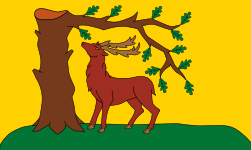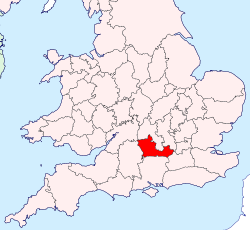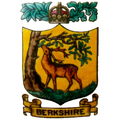Difference between revisions of "Flag of Berkshire"
m |
|||
| Line 1: | Line 1: | ||
{{Infobox flag | {{Infobox flag | ||
| Name = Berkshire | | Name = Berkshire | ||
| − | | Article = | + | | Article = |
| − | | Type = | + | | Type = |
| − | | Image = | + | | Image = Berkshire.svg |
| − | | Nickname = | + | | Nickname = |
| − | | Morenicks = | + | | Morenicks = |
| − | | Use = | + | | Use = |
| − | | Symbol = | + | | Symbol = |
| Proportion = 3:5 | | Proportion = 3:5 | ||
| − | | Adoption = | + | | Adoption = 27 February 2017 |
| − | | Design = | + | | Design = |
| − | | Designer = | + | | Designer = |
}} | }} | ||
| − | [[File:Berkshire Brit Isles Sect 5.svg|thumb| | + | [[File:Berkshire Brit Isles Sect 5.svg|thumb|250px|Berkshire]] |
| − | + | ||
| − | + | ||
| − | + | ||
| + | The '''Berkshire flag''' is the flag of the [[Berkshire|county of Berks]]. The Berkshire’s flag was registered on 27 February 2017 following declarations of support from twenty-four local organisations, backed by the Lord Lieutenant of Berkshire, James Puxley. The flag features the traditional hart (stag) and oak theme associated with the county for several centuries, which appears on the badges, emblems and logos of a large number of county organisations. | ||
| + | |||
| + | The hart and oak refer generally to the forestlands of Berkshire and specifically to the legend of a late 14th century royal huntsman named Herne The Hunter. Legend has it that after various nefarious deeds by his jealous rivals, this one time favourite of the king was dismissed from royal service and distraught, he hanged himself from an oak tree which was then struck by lightning. The hart is “one of the manifestations of his restless spirit” and, according to Michael Drayton’s poem of 1627, a banner with this badge, or something very like it, was carried by the men of Berkshire at the Battle of Agincourt “Barkshire a Stag, vnder an Oake that stood,”. | ||
| + | |||
| + | Research conducted by Brady Ells, located and identified a seal used by the former Berkshire Council before its formal acquisition of arms in 1947, which depicted the hart and stag emblem, in both monochrome and coloured versions. The flag is fashioned from this original seal. | ||
| + | |||
__TOC__ | __TOC__ | ||
| − | ==Design== | + | ==Design== |
| − | + | ||
| − | + | In the early twentieth century, the former Berkshire Council made use of a coloured seal depicting the emblem of a hart and oak tree, long associated associated with the county where a naturally brown stag stands under a similarly naturally coloured, oak tree, with leaves and surrounding grass, set against a field of gold. Possibly the golden colour is a reference to Berkshire’s status as a “Royal County”, owing to the presence there of the principal royal residence, Windsor Castle there. | |
| − | + | ||
| − | + | The notion of deploying the county’s long-associated emblem as a flag had first been mooted by David Nash Ford of the Royal Berkshire History website, who created a white and blue bicolour bearing a golden silhouette of hart and oak across the two bands | |
| − | + | ||
| − | The | + | ==Gallery== |
| − | + | <gallery> | |
| − | + | File:Berkshire_County_Council_seal.png|Berkshire Council arms | |
| − | + | File:Berkshire_flag.svg|David Nash Ford proposal | |
| − | == | + | </gallery> |
| − | < | + | |
| − | + | ||
| − | + | ||
| + | {{County flags of the United Kingdom|Berkshire}} | ||
{{DEFAULTSORT:Flag of Berkshire}} | {{DEFAULTSORT:Flag of Berkshire}} | ||
[[Category:Berkshire]] | [[Category:Berkshire]] | ||
Revision as of 15:08, 28 May 2017
| Flag of Berkshire | |

| |
| Proportion | 3:5 |
|---|---|
| Adopted | 27 February 2017 |
The Berkshire flag is the flag of the county of Berks. The Berkshire’s flag was registered on 27 February 2017 following declarations of support from twenty-four local organisations, backed by the Lord Lieutenant of Berkshire, James Puxley. The flag features the traditional hart (stag) and oak theme associated with the county for several centuries, which appears on the badges, emblems and logos of a large number of county organisations.
The hart and oak refer generally to the forestlands of Berkshire and specifically to the legend of a late 14th century royal huntsman named Herne The Hunter. Legend has it that after various nefarious deeds by his jealous rivals, this one time favourite of the king was dismissed from royal service and distraught, he hanged himself from an oak tree which was then struck by lightning. The hart is “one of the manifestations of his restless spirit” and, according to Michael Drayton’s poem of 1627, a banner with this badge, or something very like it, was carried by the men of Berkshire at the Battle of Agincourt “Barkshire a Stag, vnder an Oake that stood,”.
Research conducted by Brady Ells, located and identified a seal used by the former Berkshire Council before its formal acquisition of arms in 1947, which depicted the hart and stag emblem, in both monochrome and coloured versions. The flag is fashioned from this original seal.
Design
In the early twentieth century, the former Berkshire Council made use of a coloured seal depicting the emblem of a hart and oak tree, long associated associated with the county where a naturally brown stag stands under a similarly naturally coloured, oak tree, with leaves and surrounding grass, set against a field of gold. Possibly the golden colour is a reference to Berkshire’s status as a “Royal County”, owing to the presence there of the principal royal residence, Windsor Castle there.
The notion of deploying the county’s long-associated emblem as a flag had first been mooted by David Nash Ford of the Royal Berkshire History website, who created a white and blue bicolour bearing a golden silhouette of hart and oak across the two bands
Gallery
| County flags of the United Kingdom |
|---|
|
Aberdeenshire • Anglesey • Banffshire • Bedfordshire • Berkshire • Berwickshire • Buckinghamshire • Caernarfonshire • Caithness • Cambridgeshire • Cheshire • Cornwall • Cumberland • Derbyshire • Devon • Dorset • Durham • East Lothian • Essex • Flintshire • Glamorgan • Gloucestershire • Hampshire • Herefordshire • Hertfordshire • Huntingdonshire • Kent • Kirkcudbrightshire • Lancashire • Leicestershire • Lincolnshire • Merionethshire • Middlesex • Monmouthshire • Morayshire • Norfolk • Northamptonshire • Northumberland • Nottinghamshire • Orkney • Oxfordshire • Pembrokeshire • Rutland • Shetland • Shropshire • Somerset • Staffordshire • Suffolk • Surrey • Sussex • Sutherland • Warwickshire • Westmorland • Wiltshire • Worcestershire • Yorkshire |


